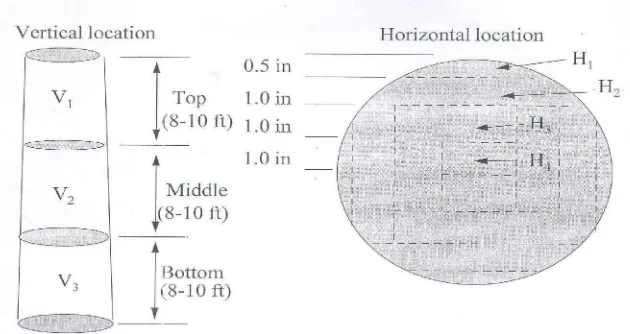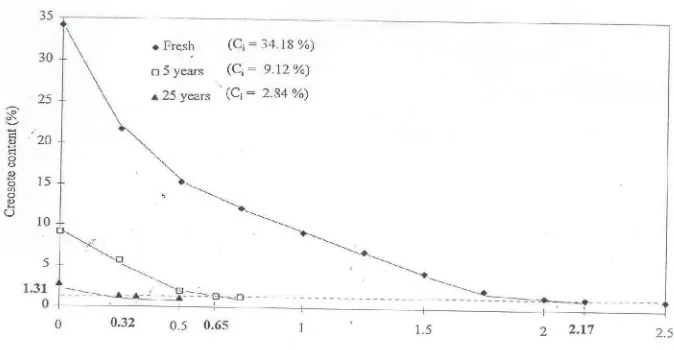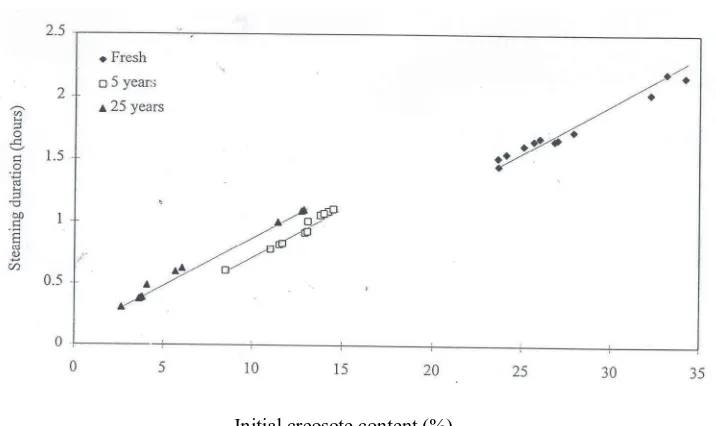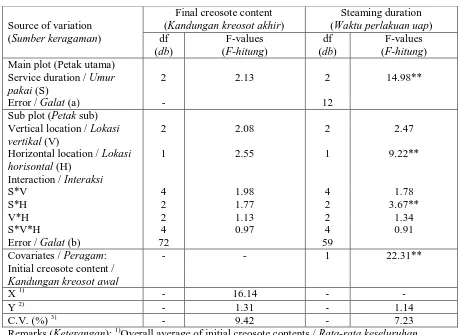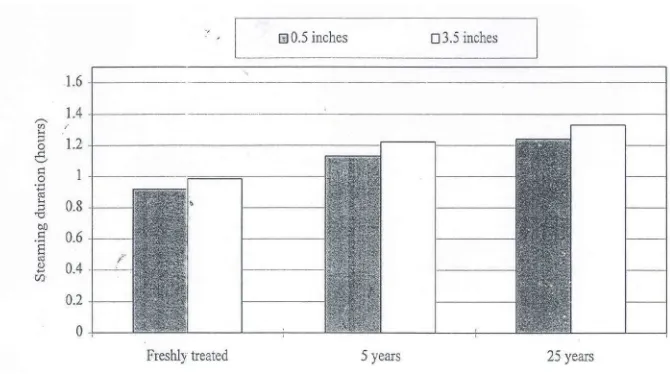(Pengeluaran Sisa Kreosot dalam Tiang Listrik Bekas Pakai menggunakan Perlakuan Uap) 1)
By / Oleh
Han Roliadi 2) & Elvin T. Choong 3) ABSTRAK
Keberadaan sisa-sisa kreosot dalam produk kayu bekas pakai dan tak lagi
digunakan, diantaranya tiang listrik bekas, dapat mengakibatkan kesulitan/masalah dalam
pemanfaatannya menjadi produk berguna lain seperti: papan blok, papan partikel, papan
serat, dan pulp/kertas. Maka, sisa kandungan kreosot tersebut harus dihilangkan atau
diturunkan menggunakan perlakuan khusus yang efektif. Sebelum perlakuan uap, tiang
listrik tedsebut perlu dibuat menjadi partikel-partikel berukuran kecil, antara lain serbuk
gergaji sehingga memudahkan penguapan kreosot oleh uap.
Perlakuan uap terhadap tiang listrik bekas pakai telah dicoba keefektifannya dalam
menghilangkan/menurunkan sisa kandungan kreosotnya. Hasil menunjukkan bahwa
perlakuan uap dapat menurunkan kandungan kreosot hingga 1,31 persen, untuk kandungan
awal kreosotnya yang berbeda-beda. Tiang listrik dengan kandungan kreosot lebih tinggi
membutuhkan waktu perlakuan uap lebih lama. Pada kandungan awal kreosot tertentu
atau sama, penurunan/pengeluaran kreosot pada batang/tiang listrik bekas yang berumur
pakai lebih lama ternyata lebih sulit dari pada tiang listrik berumur lebih muda. Pada
berbagai umur Selanjutnya baik pada tiang listrik berumur lebih muda ataupun lebih tua,
penurunan/pengeluaran kresosote juga lebih sulit pada bagian dalam batang/tiang
dibandingkan dari bagian yang lebih dekat permukaan batang/tiang.
Perlakuan uap merupakan cara yang murah dan efisien menurunkan kandungan
cara lain, antara lain dengan pelarut organik yang memerlukan biaya mahal dan
penggunaan mikororganisme tertentu yang memerlukan waktu lebih lama.
Keywords: Perlakuan uap, sisa kreosot, tiang listrik bekas pakai, keausan, dan tiang listrik baru/segar diawetkan
______________________________________ 1)
Naskah ini merupakan bagian dari disertasi doktor pengarang pertama pada Lousiana State University, Baton Rouge, LA, USA, 1997
2)
Pusat Pengembangan dan Teknologi Hasil Hutan, Bogor, Indonesia 3)
School of Forestry, Wildlife, and Fisheries, Louisiana State University, Baton Rouge, LA, USA
ABSTRACT
The presence of residual creosote in out-of-service weathered creosote-treated wood
products, such as used utility poles, can bring about problems/troubles in their reutilization
into other useful products (e.g. block board, particleboard, fiberboard, and pulp/paper).
Therefore, their residual creosote content should be removed/reduced by particular effective
treatment. Prior to the steaming, the poles should be converted to smaller-size particles (i.e.
sawdust) to ensure more effective creosote volatilization by steam.
Steam treatment of weathered out-of-service utility poles has been experimented to
evaluate its effectiveness in removing their residual creosote content. The results revealed
that steaming reduced the creosote to a 1.31-percent level, regardless of different initial
creosote contents. Poles with higher initial creosote content required longer steaming
duration. At a given initial content, creosote removal from weathered poles and from
materials in the inner pole portion was more difficult than that from freshly treated poles
and the outer portion. Regardless of pole ages, creosote removal from the inner portion of
the poles was also more difficult than the outer portion. Steaming could prove an efficient
and cheap way for creosote removal. Further reduction in residual creosote content in the
poles below 1.31 percent can be done by other methods (e.g. more costly solvent extraction
Keywords: steaming, residual creosotes, out-of-service utility poles, weathering, and freshly treated poles
______________________________________ 1)
This article is a part of the first author’s doctoral dissertation at the Louisiana State University, Baton Rouge, LA, USA, 1997
2)
Research and Development Center for Forest Products Technology, Bogor, Indonesia 3)
School of Forestry, Wildlife, and Fisheries, Louisiana State University , Baton Rouge, LA, USA
I. INTRODUCTION
Attention has long been placed on removing or reducing creosote preservative in
weathered treated wood products which were no longer serviceable, among others utility
poles, before being utilized/processed into particular useful products, e.g. block board,
particleboard, fiberboard, and pulp/paper. This is because the residual creosote can bring
about troubles/problems in that processing. Two methods of creosote removal have been so
far experimentally tried, i.e. (1) bioremediation and (2) solvent extraction. Bioremediation
is a biological process using organisms that can “consume” the preservative. An
experiment done by Eslyn (1976) on creosote-treated marine piles showed that
approximately 80 percent of the creosote can be eliminated, but the processing is
exhaustively time-consuming. The microorganisms used for his work was Pseudomonas
creosotensis. Using water-nutrient broth, the incubation took about nine days.
The LSU (Louisiana State University) Institute for Environmental Studies has
conducted solvent (methanol) extraction on severely weathered creosote-treated wood. This
extraction could remove almost 100 percent of the creosote (Portier et. al., 1994).
However, the creosote-removal by this method in large-scale implementation can required
the use of expensive methanol solvent and costly extraction apparatus. Therefore, “cheaper
and not too lengthy” method to remove this creosote should be found out, such as steaming..
Steaming is often used in preservative treatment, especially by the vacuum-pressure
Steaming is also used to separate the volatile compounds in wood extractives (Browning
1967). Since creosote contains compounds that ranges from low-boiling fractions (i.e. more
volatile) to high-boiling fractions (less volatile), steaming can expectedly volatilize the
creosote thereby removing or reducing it in the creosote-treated wood.
II. MATERIALS AND METHODS A. Materials
Samples of sawdust from the sawing on the utility poles of southern yellow pine
species as previously used for creosote-content determination (Roliadi, et. al. 2000) were
collected from various vertical and horizontal locations in 5- and 25-year weathered
out-of-service poles and freshly treated poles (Figure 1). For replication, five poles were taken
from each group of pole ages.
[image:4.624.147.462.390.557.2]
Figure 1. Patterns of cutting/sawing procedures in treated poles
Gambar 1. Pola prosedur pemotongan/penggergajian tiang listrik yang diawetkan
Translation of English words in Figure 1 into Indonesian (Terjemahan kata-kata bahasa Inggris dalam Gambar 1 ke bahasa Indonesia): Vertical location = Lokasi vertikal; Top = Bagian atas; Middle = Bagian tengah; Bottom = Bagian dasar; and/dan Horizontal location = Lokasi horisontal.
B. Methods
Each of these samples weighing about 5 grams, with predetermined creosote content
using toluene extraction (AWPA Standard, 1984), was placed in fritted glass crucible and
minute interval, the samples in the glass crucibles were removed from the retort and washed
with boiling water to facilitate as much creosote removal as possible. The possible
remaining creosote contents in the samples were determined again in accordance with the
corresponding AWPA Standard (1984). Steam treatment was terminated, when the residual
creosote contents became stable and were further considered as the final contents. The
criteria used to evaluate the effectiveness of steam treatment were final creosote content and
steaming duration.
C. Data Analysis
In order to assist the data evaluation (i.e. final creosote content and steaming
duration), statistical analysis that employed repeated-measurement design was used,
whereby pole ages (i.e. freshly treated, and 5 and 25 years) acted as the main plot, various
vertical and horizontal locations in the poles as the sub plot, initial creosote contents as the
covariate, and five poles taken from each age group as replicate.
II. RESULTS AND DISCUSSION
In general, steaming reduced creosote to a final content that ranged about 1.2 – 1.5
percent regardless of different initial contents (Figure 2). Heat from the steam caused the
volatilization of compounds in creosote and lowered their viscosity, thereby greatly
assisting the movement of creosote, which is not chemically held in wood. However, the
capability of steam treatment was limited to about 1.2 – 1.5 percent final creosote content,
which is less effective than solvent extraction and bioremediation. This is because creosote
is oil-soluble and therefore immiscible in a polar substance (steam). Also, creosote left at
that low percentage might contain greater fractions of high-boiling compounds which are
[image:6.624.126.463.71.246.2]
Steaming duration (hours)
Figure 2. Approximate steaming durations required in 3 kinds of creosote-treated
poles (i.e. 2.17 hours for freshly treated poles; 0.65 hours for 5-; and 0.32 hours for 25-year weathered poles, respectively) to reach 1.31 % final creosote
content (Ci = initial creosote content)
Gambar 2. Perkiraan waktu perlakuan uap yang diperlukan pada 3 macam tiang listrik yang diawetkan dengan kreosot (2,17 jam untuk tiang listrik baru/segar
diawetkan; 0,65 jam untuk tiang listrik berumur 5 tahun; dan 0,32 jam untuk tiang listrik berumur 25 tahun) guna mencapai kandungan kreosot akhir 1,31 % (Ci = kandungan kreosot awal)
Translation of English words in Figure 2 into Indonesian (Terjemahan kata-kata bahasa Inggris dalam Gambar 2 ke bahasa Indonesia): Steaming duration (hours) = Waktu perlakuan uap (jam); Fresh = Tiang listrik baru/segar diawetkan; 5 years = Tiang listrik diawetkan telah berumur 5 tahun; 25 years = Tiang listrik diawetkan telah berumur 25 tahun; dan/and Creosote content (%) = Kandungan kreosot (%).
The analysis of variance (Table 1) reveals that that the final creosote contents were
not significantly different among all the variable tested (i.e. poles, ages and various vertical
and horizontal locations, and hence those final contents could be averaged, i.e. 1.31 percent.
The approximate steaming duration for various initial creosote contents could be
determined, as shown in Figure 2, by interpolating it to the overall 1.31-percent average,
which was regarded as the effective final creosote content. As a result, when the
experimental data of initial creosote content were plotted against the steaming duration
[image:7.624.126.484.67.280.2]
Initial creosote content (%)
Figure 3. Relationship between initial creosote content and steaming duration to reach 1.31 % final creosote content
Gambar 3. Hubungan antara kandungan kreosot awal dan waktu perlakuan uap untuk mencapai kandungan akhir kreosot 1.31 %
Translation of English words in Figure 3 into Indonesian (Terjemahan kata-kata bahasa Inggris dalam Gambar 3 ke bahasa Indonesia): Initial creosote content (%) = Kandungan kreosot awal (%); Fresh = Tiang listrik baru/segar diawetkan; 5 years = Tiang listrik diawetkan telah berumur 5 tahun; 25 years = Tiang listrik diawetkan telah berumur 25 tahun; and/dan Steaming duration (hours) = Waktu perlakuan uap (jam).
In addition, the analysis of variance on steaming duration (Table 1), which
incorporated the initial creosote contents, explained the effect of various locations in the
poles and different service durations (pole ages), whereby the overall initial contents were
statistically assumed as constant. At that constant initial creosote, i.e. 6.14 percent (Table
1), steaming duration of samples from pole of older ages and of the outer portions was
actually longer than that of freshly treated poles and of the inner portion, respectively
(Figure 4). More difficulty in steaming of older poles again confirmed that the residual
creosote in 5- and 25-year weathered poles contained greater high-boiling fractions, due to
more evaporation of low-boiling compounds, as compared to those in the freshly treated
poles. On the other hand, more difficult creosote removal from the inner pole portion could
analysis of variance further reveals that different vertical locations in poles did not
[image:8.624.82.541.174.509.2]significantly affect steaming duration.
Table 1. Analysis of variance on final creosote content and steaming duration
Tabel 1. Analisa keragaman terhadap kandungan kreosot akhir dan waktu perlakuan uap
Source of variation
Final creosote content (Kandungan kreosot akhir)
Steaming duration (Waktu perlakuan uap) (Sumber keragaman) df
(db) F-values (F-hitung) df (db) F-values (F-hitung) Main plot (Petak utama)
Service duration / Umur pakai (S)
2 2.13 2 14.98**
Error / Galat (a) - 12
Sub plot (Petak sub) Vertical location / Lokasi vertikal (V)
2 2.08 2 2.47
Horizontal location / Lokasi horisontal (H)
1 2.55 1 9.22**
Interaction / Interaksi
S*V 4 1.98 4 1.78
S*H 2 1.77 2 3.67**
V*H 2 1.13 2 1.34
S*V*H 4 0.97 4 0.91
Error / Galat (b) 72 59
Covariates / Peragam: Initial creosote content / Kandungan kreosot awal
- - 1 22.31**
X 1) - 16.14 - -
Y 2) - 1.31 - 1.14
C.V. (%) 3) - 9.42 - 7.23
[image:9.624.129.464.70.257.2]
Service duration
Figure 4. Steaming duration required in sawdust samples from three kinds of treated poles (freshly treated, and 5- and 25-year weathered poles) at 0.5-inch distance (outer portion) and 3.5-inch distance (inner portion) from pole surface, by assuming that their initial creosote contents were the same (i.e. 16.14 %) Gambar 4. Waktu perlakuan uap yang diperlukan pada contoh serbuk gergaji dari tiga macam tiang listrik yang diawetkan (baru/segar diawetkan, berumur pakai 5 tahun, dan berumur pakai 25 tahun) pada jarak 0,5 inci (bagian lebih luar) dan pada jarak 3,5 inci (bagian lebih dalam) dari permukaan tiang listrik, dengan asumsi bahwa kandungan kreosot awalnya sama (16,14 persen)
Translation of English words in Figure 4 into Indonesian (Terjemahan kata-kata bahasa Inggris dalam Gambar 4 ke bahasa Indonesia): Service duration = Masa pakai tiang listrik; Freshly treated = Tiang listrik baru/segar diawetkan; 5 years = Tiang listrik diawetkan telah berumur 5 tahun; 25 years = Tiang listrik diawetkan telah berumur 25 tahun; 0.5 inches implies the distance from pole surface (outer portion) toward the pole core = 0,5 inci menunjukkan jarak dari permukaan tiang listrik (bagian lebih luar tiang listrik) menuju ke bagian pusat tiang listrik; 3.5 inches implies the distance from pole surface (outer portion) toward the pole core = 3,5 inci menunjukkan jarak dari permukaan tiang listrik (bagian lebih luar tiang listrik) menuju ke bagian pusat tiang listrik; and/dan Steaming duration (hours) = Waktu perlakuan uap (jam).
IV. CONCLUSSIONS AND SUGGESTIONS
Trial on removal of out-of service using steam treatment was conducted by at first
converting the poles into smaller-size particles, i.e. sawdust. In this way, therefore, it will
inflict more effective creosote removal, because sawdust particles has substantially much
larger surface area than the corresponding poles. As a result, there would be more intimate
contact between creosote stuffs and hot steam, thereby incurring effective volatilization of
The initial creosote contents in sawdust samples from the creosote-treated poles
correlated positively with steaming duration. Regardless of different initial creosote
contents, steaming reduced the creosote to 1.31 percent level. Beyond this level, steaming
brought about no significant reduction in creosote content.
At a given initial creosote content, removal of creosote by steam was more difficult
for poles with longer service duration (i.e. older ages) than with shorter duration/younger
ages, and for pole materials from the inner portion than the portion near the surface.
Steaming, however, can be an efficient and cheap method of reducing the creosote
content in weathered poles. Further removal for effective treatment can be done by other
methods (e.g. more costly solvent extraction and time-consuming bioremediation).
LITERATURE CITED
AWPA (American Wood Preservers’ Association) Standard. 1984. Method for the determination of oil-type preservative in wood. AWPA A6-83, Stevensville, MD (USA), pg. 1-7.
Andrew, J.W. 1952. Volatility of some of the compounds in creosote produced from high- temperature tar. Proc. of Am. Wood Preserv. Assoc, 48: 85-98
Browning, B. L. 1967. Methods of Wood Chemistry. Interscience Publishers. A Division of John Wiley & Sons. New York – London – Sydney.
Eaton, R.A. and M.D.C. Hale. 1993. Wood: Decay, Pests, and Protection. Chapman and Hall. London – Glasgow – New York – Tokyo – Melbourne.
Esslyn, W.E. 1976. Wood preservative degradation by marine borers. Proceedings of the Third International Biodegradation. 679 – 686 pp. Applied Science J. Publ. Ltd. London (UK)
Hickin, N.E. 1971. Wood preservation: A Guide to the Meaning of Terms. Hutchinson and Co. Ltd. London
